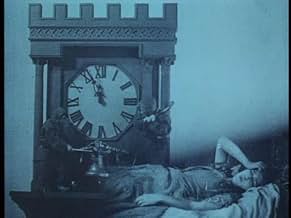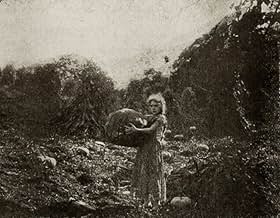Cinderella
- 1914
- 52min
PUNTUACIÓN EN IMDb
6,0/10
1,1 mil
TU PUNTUACIÓN
Aunque maltratada por su cruel madrastra y hermanastras, Cenicienta puede asistir al baile real con la ayuda de un hada madrina.Aunque maltratada por su cruel madrastra y hermanastras, Cenicienta puede asistir al baile real con la ayuda de un hada madrina.Aunque maltratada por su cruel madrastra y hermanastras, Cenicienta puede asistir al baile real con la ayuda de un hada madrina.
Reseñas destacadas
Mary Pickford is perfectly cast here as the put-upon sister living as a drudge for her stepmother (Isabel Vernon) and her two daughters. Director James Kirkwood and the costumiers have done well to portray both Lucille Carney and Georgia Wilson as well as their mother as rather ghastly individuals whilst ensuring that Pickford retains the butter-wouldn't-melt look. The story unfolds fairly faithfully, albeit substantially condensed, to the Perrault story as the King holds a ball to try and get his handsome son (Owen Moore) hitched. Naturally, a scullery maid isn't on the guest list but the timely intervention of her fairy godmother (Inez Ranous) ensures that she can go and do some royal dazzling. It's a little bit static at times, but the visual affects are charmingly applied and there's a clear chemistry between the couple that fate has thrown together. There is also a little light-heartedness at times too as it unfolds and just desserts a-plenty at the conclusion. It just goes to show what you can do with an engaging story and people who know how to play to the camera.
This is fairly well made for 1914, and it's been restored and presented in a higher quality than most films from that period, including some lovely color tinting. It'd be nice if other early silent films were made available in such quality as Mary Pickford's vehicles have been, but we'll take what we can get, I suppose. In addition, the well-known fairytale narrative makes this an ideal candidate from the early phase of feature-length films to see on DVD if you're not already an avid viewer of ancient cinema.
This is an early example of expert focus on filming and staging around the star. Pickford is filmed in the best lighting; her face is nearly always center stage, even if it means blocking or not showing frontal views of others; and there are a good number of close-ups mostly for her. That's for the best, by the way, as not much else here seems as appealing or talented, including Owen Moore, Pickford's real-life husband at the time, as Prince Charming. Otherwise, the film-making here is rather prosaic even for 1914; for example, notice how they return to the same camera positions for scenes in the kitchen, bedroom and ballroom. The framing for the kitchen scenes are very similar to those of the kitchen scenes in the 1911 Thanhouser version of Cinderella, which I saw recently before this.
The clock dream is amusing and creative, though. It begins as a superimposed vision above sleeping Cinderella and then becomes its own shot crosscut with her sleeping. The nice added score helps, too. It's worth comparing this to the dance of the clocks nightmare in Méliès's 1899 "Cinderella", as well as the one in his 1912 version. I also like the through-the-window framing of Cinderella looking out the window at dancing fairies during her other sleeping scene; it's also one of the few times Pickford's back is to the camera.
There were other stars in 1914, but I haven't seen any of them receive this good of treatment, with such classical star focus, for another year or two. Nobody, however, was bigger then in the movie world than was Mary Pickford.
This is an early example of expert focus on filming and staging around the star. Pickford is filmed in the best lighting; her face is nearly always center stage, even if it means blocking or not showing frontal views of others; and there are a good number of close-ups mostly for her. That's for the best, by the way, as not much else here seems as appealing or talented, including Owen Moore, Pickford's real-life husband at the time, as Prince Charming. Otherwise, the film-making here is rather prosaic even for 1914; for example, notice how they return to the same camera positions for scenes in the kitchen, bedroom and ballroom. The framing for the kitchen scenes are very similar to those of the kitchen scenes in the 1911 Thanhouser version of Cinderella, which I saw recently before this.
The clock dream is amusing and creative, though. It begins as a superimposed vision above sleeping Cinderella and then becomes its own shot crosscut with her sleeping. The nice added score helps, too. It's worth comparing this to the dance of the clocks nightmare in Méliès's 1899 "Cinderella", as well as the one in his 1912 version. I also like the through-the-window framing of Cinderella looking out the window at dancing fairies during her other sleeping scene; it's also one of the few times Pickford's back is to the camera.
There were other stars in 1914, but I haven't seen any of them receive this good of treatment, with such classical star focus, for another year or two. Nobody, however, was bigger then in the movie world than was Mary Pickford.
Really this film isn't very good, but echoing another comment I made somewhere on here, don't you think making movies used to be more fun? The ugly sisters played by a bunch of ridiculous men? The gaggle of silly kids that are the forest fairies? they must have had a blast! I guess because these weren't considered art there was no pretension that they should be classy. the tone of it was a little like a john waters film. The trick to enjoying a film like this is to forget how important movies are to us, as people, as a culture, as individuals. I tell people I'm an independent film maker and generally the regard that either like I must be crazy or like I'm doctor or something, which is cool, but imagine back in the days when you'd have been treated like hustler like a pimp, how could you treat yourself that seriously? Anyways, this movie is pretty much totally dumb, but so is Cinderella. The whole shoe thing? He falls in love with a girl who he's never met and doesn't even get a name out of, and decides to track her down by having every woman in the land try on her shoe? so why didn't the shoe turn back into a pumpkin or squash or whatever? no one in the kingdom had Cinderella's shoe size? if he never met her but she was dressed like princess wouldn't it be a safe assumption that she's not actually in your kingdom? royalty tends to know the other royalty nearby. and also if he's so damn in love with why can't he pick out her face? it can't have looked that different without the accoutrement of the ball. also: he's going to marry a peasant? is he crazy? the king and queen don't want him to use that marriage for something beneficial like making peace or pooling power with allies? all the while everyone knows he probably could have just hired poor Cinderella, put her up at the castle and had his way with her any time he felt like it, which is pretty much what royalty did back then. for example henry the... what the crap was I saying? I got distracted. oh, yeah. I would give anything to have worked on a movie like this. but that doesn't mean you'll enjoy the movie per Se.
This is a 1914 uncomplicated version of the famous tale. The stage production is quite simple, the plot develops with seveal abrupt changes, and other characters could have been better displayed, yet one more time Mary Pickford both entertains and interests us with her art. It is not one of her best pictures, nor one of her best known ones, but it has the simple charm of a children´s tale.
A curiosity about this picture is that Owen Moore, her first husband, plays Prince Charming. They eloped to be married in 1911 and would divorce in 1920; the same month of their divorce, Mary married Douglas Fairbanks.
A curiosity about this picture is that Owen Moore, her first husband, plays Prince Charming. They eloped to be married in 1911 and would divorce in 1920; the same month of their divorce, Mary married Douglas Fairbanks.
No need to seek this out. It is mundane in every way except one.
You'll remember that a feature of the story is the clock. Our girl has to be home before midnight, her only rule. She disobeys because she is having such a nice time.
We forgive her, because her life has been so rough, but rules is rules. She makes her escape just as the clock is striking. But in this movie, she has nightmares about the clock, and they are pretty interesting.
First we have two mechanical bellringers moved into place to strike the bell. These, as it turns out are gnomes we have seen before when the evil stepsisters visited a fortune teller. Since then, Cinderella has had pleasant dreams of fairies and the bad sisters nightmares of these gnomes.
Now Cinderella is visited by these two gnomes, in a sequence labelled "the consequences of disobedience." They strike the bell, then things go haywire and they hit each other. Then the hands go haywire, and the face itself starts spinning. Next the clocktower itself shakes and the gnomes fall off. Wait, thats not all. There's a fantastic sequence where the numbers on the clock face become untethered and start to roam about the face while the hands twist radically.
Its very clever. I think both the clock and the gnomes are cinematic additions. And they do spice up the otherwise ordinary event.
Ted's Evaluation -- 2 of 3: Has some interesting elements.
You'll remember that a feature of the story is the clock. Our girl has to be home before midnight, her only rule. She disobeys because she is having such a nice time.
We forgive her, because her life has been so rough, but rules is rules. She makes her escape just as the clock is striking. But in this movie, she has nightmares about the clock, and they are pretty interesting.
First we have two mechanical bellringers moved into place to strike the bell. These, as it turns out are gnomes we have seen before when the evil stepsisters visited a fortune teller. Since then, Cinderella has had pleasant dreams of fairies and the bad sisters nightmares of these gnomes.
Now Cinderella is visited by these two gnomes, in a sequence labelled "the consequences of disobedience." They strike the bell, then things go haywire and they hit each other. Then the hands go haywire, and the face itself starts spinning. Next the clocktower itself shakes and the gnomes fall off. Wait, thats not all. There's a fantastic sequence where the numbers on the clock face become untethered and start to roam about the face while the hands twist radically.
Its very clever. I think both the clock and the gnomes are cinematic additions. And they do spice up the otherwise ordinary event.
Ted's Evaluation -- 2 of 3: Has some interesting elements.
¿Sabías que...?
- CuriosidadesMary Pickford (Cinderella) and Owen Moore (Prince Charming) were married in real life from 1911-20.
- ConexionesFeatured in Mary Pickford: A Life on Film (1997)
Selecciones populares
Inicia sesión para calificar y añadir a tu lista para recibir recomendaciones personalizadas
Detalles
- Duración
- 52min
- Color
- Mezcla de sonido
- Relación de aspecto
- 1.33 : 1
Contribuir a esta página
Sugerir un cambio o añadir el contenido que falta























